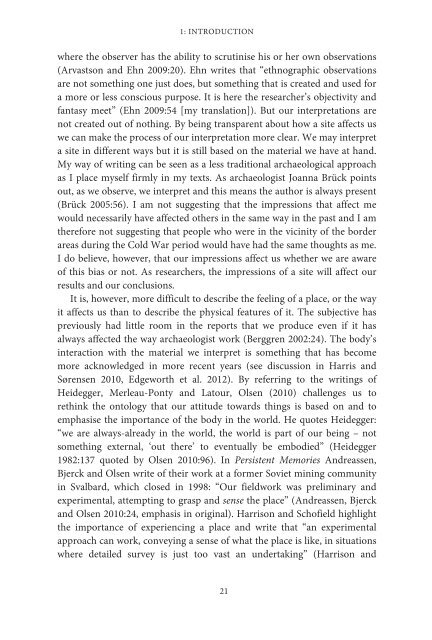1JZGauQ
1JZGauQ
1JZGauQ
Create successful ePaper yourself
Turn your PDF publications into a flip-book with our unique Google optimized e-Paper software.
1: INTRODUCTION<br />
where the observer has the ability to scrutinise his or her own observations<br />
(Arvastson and Ehn 2009:20). Ehn writes that “ethnographic observations<br />
are not something one just does, but something that is created and used for<br />
a more or less conscious purpose. It is here the researcher’s objectivity and<br />
fantasy meet” (Ehn 2009:54 [my translation]). But our interpretations are<br />
not created out of nothing. By being transparent about how a site affects us<br />
we can make the process of our interpretation more clear. We may interpret<br />
a site in different ways but it is still based on the material we have at hand.<br />
My way of writing can be seen as a less traditional archaeological approach<br />
as I place myself firmly in my texts. As archaeologist Joanna Brück points<br />
out, as we observe, we interpret and this means the author is always present<br />
(Brück 2005:56). I am not suggesting that the impressions that affect me<br />
would necessarily have affected others in the same way in the past and I am<br />
therefore not suggesting that people who were in the vicinity of the border<br />
areas during the Cold War period would have had the same thoughts as me.<br />
I do believe, however, that our impressions affect us whether we are aware<br />
of this bias or not. As researchers, the impressions of a site will affect our<br />
results and our conclusions.<br />
It is, however, more difficult to describe the feeling of a place, or the way<br />
it affects us than to describe the physical features of it. The subjective has<br />
previously had little room in the reports that we produce even if it has<br />
always affected the way archaeologist work (Berggren 2002:24). The body’s<br />
interaction with the material we interpret is something that has become<br />
more acknowledged in more recent years (see discussion in Harris and<br />
Sørensen 2010, Edgeworth et al. 2012). By referring to the writings of<br />
Heidegger, Merleau-Ponty and Latour, Olsen (2010) challenges us to<br />
rethink the ontology that our attitude towards things is based on and to<br />
emphasise the importance of the body in the world. He quotes Heidegger:<br />
“we are always-already in the world, the world is part of our being – not<br />
something external, ‘out there’ to eventually be embodied” (Heidegger<br />
1982:137 quoted by Olsen 2010:96). In Persistent Memories Andreassen,<br />
Bjerck and Olsen write of their work at a former Soviet mining community<br />
in Svalbard, which closed in 1998: “Our fieldwork was preliminary and<br />
experimental, attempting to grasp and sense the place” (Andreassen, Bjerck<br />
and Olsen 2010:24, emphasis in original). Harrison and Schofield highlight<br />
the importance of experiencing a place and write that “an experimental<br />
approach can work, conveying a sense of what the place is like, in situations<br />
where detailed survey is just too vast an undertaking” (Harrison and<br />
21




